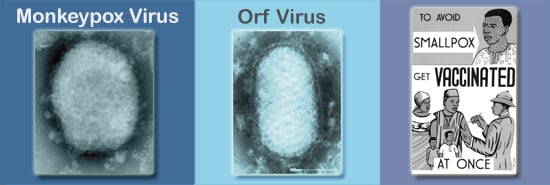Poxvirus
Poxviruses are brick or oval-shaped viruses with large double-stranded DNA genomes. Poxviruses exist throughout the world and cause disease in humans and many other types of animals. Poxvirus infections typically result in the formation of lesions, skin nodules, or disseminated rash.
Infection in humans usually occurs due to contact with contaminated animals, people, or materials. While some poxviruses, such as smallpox (variola virus), no longer exist in nature, other poxviruses can still cause disease. These include monkeypox virus, orf virus, molluscum contagiosum, and others.

While some poxviruses, such as smallpox (variola virus), no longer exist in nature, other poxviruses can still cause disease.
Smallpox is a serious, contagious, and sometimes fatal infectious disease. There is no specific treatment for smallpox disease, and the only prevention is vaccination. The last naturally occurring case in the world was in Somalia in 1977.